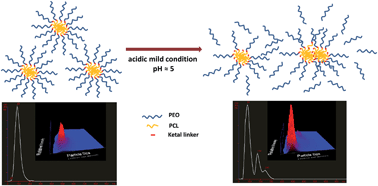Novel poly(ethylene oxide monomethyl ether)-b-poly(ε-caprolactone) diblock copolymers containing a pH-acid labile ketal group as a block linkage†
Abstract
A new biocompatible and biodegradable diblock copolymer that contains a specific acid-labile degradable linkage (acyclic ketal group) between the hydrophobic poly(ε-caprolactone) (PCL) and the hydrophilic poly(ethylene oxide monomethyl ether) (MPEO) blocks is described herein. A multi-step synthetic method that combines carbodiimide chemistry, a “click” reaction and ring-opening polymerization (ROP) was employed to successfully produce a series of MPEO-b-PCL diblock copolymers (herein referred to as MPEO44-b-PCL17 and MPEO44-b-PCL44). 2-{[2-(2-Azidoethoxy)propan-2-yl]}ethan-1-ol was obtained as a linker between the two blocks through a three-step synthetic approach. Furthermore, a newly developed α-methoxy-ω-hydroxy-poly(ethylene oxide) that contains an acid-labile ketal linkage was designed as a macroinitiator via a “click” reaction for the sequential controlled ring-opening polymerization of ε-CL. The newly obtained compounds (precursors, macromer, macroinitiator and final diblock copolymers) were assessed by 1H NMR, 13C NMR and FT-IR spectroscopy and SEC analysis, which are described in this manuscript. Upon dissolution in a mild organic solvent, the MPEO44-b-PCL17 block copolymer self-assembled in water–PBS into regular, spherical, stable nanoparticles (NPs). Furthermore, the presence of the acid-labile ketal linker enabled the disassembly of these nanoparticles in a buffer that simulated acidic cytosolic or endosomal conditions in tumour cells as evaluated by dynamic light scattering (DLS), nanoparticle tracking analysis (NTA) and transmission electron microscopy (TEM) images. This disassembly led to hydrolysis profiles that resulted in neutral degradation products.


 Please wait while we load your content...
Please wait while we load your content...